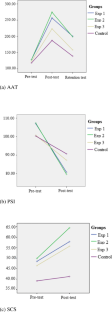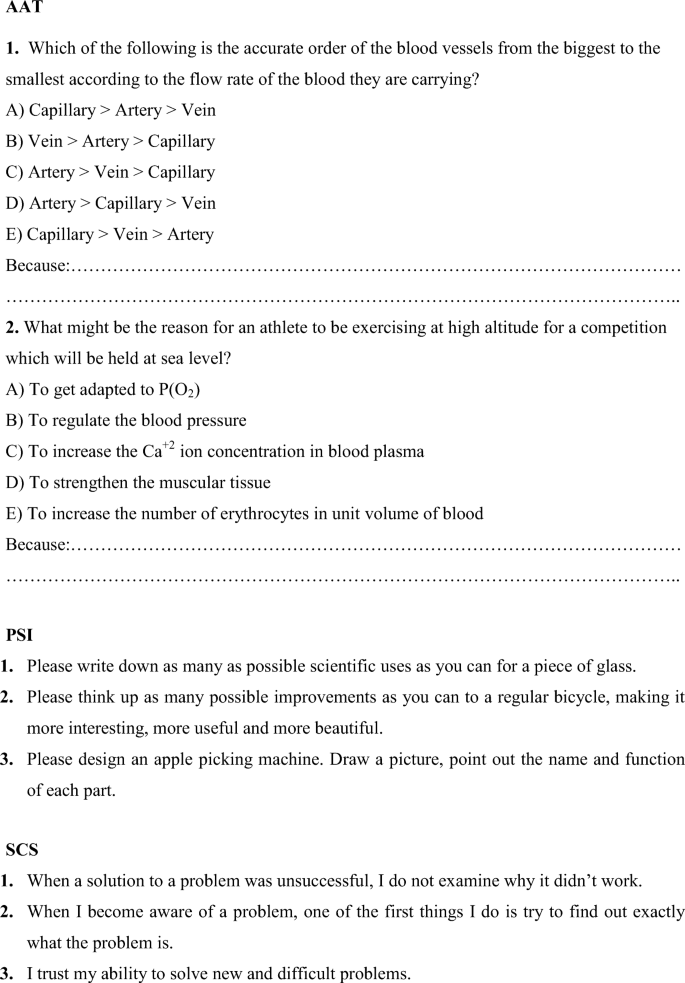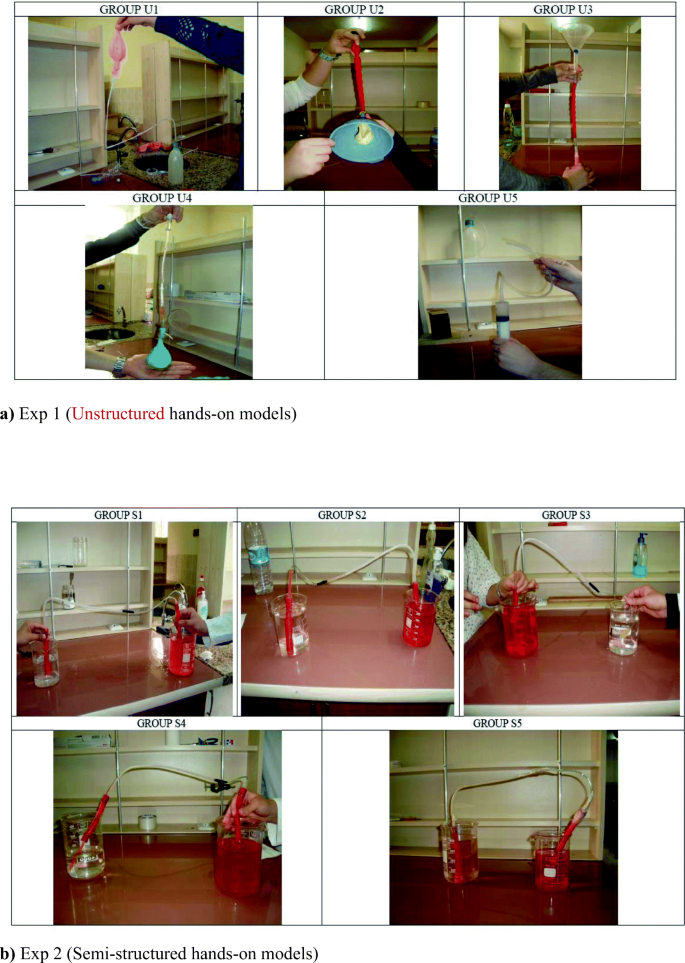Abstract
The purpose of the current study is to investigate the effectiveness of unstructured, semi-structured, structured hands-on modeling activities and traditional teaching methods in developing academic achievement, problem-solving skills, and scientific creativity in prospective science teachers in the subject of the human circulatory and respiratory systems. A pre-test–post-test quasi-experimental design was used to investigate the treatment effect. There were three experimental groups and a control group in a total of 88 prospective science teachers who were enrolled in the Department of Science Education. The Academic Achievement Test (AAT), Problem-Solving Inventory (PSI), and Scientific Creativity Scale (SCS) were applied as data collection tools. The researchers employed two-way ANOVA and ANCOVA to analyze the data. Results revealed that all modeling activities were effective in enhancing participants’ AAT scores when compared with those of the control group. In addition, unstructured modeling and semi-structured modeling activities were more effective than structured modeling activities in improving AAT scores. For the AAT retention test, unstructured and semi-structured modeling groups showed better performance than the structured modeling group and control group. Moreover, there was a statistically significant difference in PSI scores of the participants in favor of unstructured and semi-structured modeling activities. Lastly, there was no statistically significant difference in SCS scores with the experimental groups and control group.

Similar content being viewed by others
References
Akben, N. (2018). Effects of the problem-posing approach on students’ problem solving skills and metacognitive awareness in science education. Research in Science Education, 1–23. doi:https://doi.org/10.1007/s11165-018-9726-7.
Alkhawaldeh, S. A. (2007). Facilitating conceptual change in ninth grade students’ understanding of human circulatory system concepts. Research in Science & Technological Education, 25(3), 371–385. https://doi.org/10.1080/02635140701535331.
Arslan, A. (2013a). The effects of modeling based science and technology teaching on understanding, memorization, creativity and mental models of primary school students. Master Thesis, Akdeniz University.
Arslan, A. (2013b). The examination of pre-service teachers' science process skills and conceptual change in inquiry and model based inquiry environment. Master Thesis, Marmara University.
Bamberger, Y. M., & Davis, E. A. (2013). Middle-school science students’ scientific modelling performances across content areas and within a learning progression. International Journal of Science Education, 35(2), 213–238. https://doi.org/10.1080/09500693.2011.624133.
Bybee, R. (2014). NGSS and the next generation of science teachers. Journal of Science Teacher Education, 25, 211–221. https://doi.org/10.1007/s10972-014-9381-4.
Campbell, T., Oh, P., Maughn, M., Kiriazis, N., & Zuwallack, R. (2015). A review of modeling pedagogies. Eurasia Journal of Mathematics, Science & Technology Education, 11(1), 159–176. https://doi.org/10.12973/eurasia.2015.1314a.
Chi, M. T. H. (2005). Commonsense conceptions of emergent processes: why some misconceptions are robust. The Journal of the Learning Sciences, 14(2), 161–199. https://doi.org/10.1207/s15327809jls1402_1.
Chi, M. T. H., Chiu, M. H., & deLeeuw, N. (1991). Learning in a non-physical science domain: the human circulatory system. Pittsburgh: Learning Research and Development Center.
Cohen, J. (1988). Statistical power analysis fort the behavioral sciences (2nd ed.). Hillsdale: Erlbaum.
Coll, R., & Lajium, D. (2011). Modeling and the future of science learning. In M. Khine & I. Saleh (Eds.), Models and modeling (pp. 3–21). Dordrecht: Springer. https://doi.org/10.1007/978-94-007-0449-7_1.
Collin, A., & Ferguson, W. (1993). Epistemic forms and epistemic games: structures and strategies for guiding inquiry. Educational Psychologist, 28(1), 25–42. https://doi.org/10.1207/s15326985ep2801_3.
Demirhan, E., & Şahin, F. (2015). Fen bilgisi öğretmen adaylarına yönelik iki aşamalı başarı testi geliştirilmesi: İnsanda dolaşım ve solunum [Developing a two-tier achievement test for prospective science teachers: The human circulation and respiration]. ERPA International Congresses on Education, 4-7 June 2015, Athens.
Deniş Çeliker, H., & Balım, A. G. (2012). Adaptation of scientific creativity test to Turkish and ıt’s assessment criteria. Usak University Journal of Social Sciences, 5(2), 1–21.
Devetak, I., Hajzeri, M., Glažar, A. S., & Vogrinec, J. (2010). The influence of different models on 15-years old students’ understanding of the solid state of matter. Acta Chimica Slovenica, 57, 904–511.
Fraenkel, J. R., & Wallen, N. E. (2005). How to design and evaluate research in education. (6th ed). New York: McGraw-Hill International Edition.
Frederiksen, J. R., White, B. Y., & Gutwill, J. (1999). Dynamic mental models in learning science: the importance of constructing derivational linkages among models. Journal of Research in Science Teaching, 36(7), 806–836. https://doi.org/10.1002/(SICI)1098-2736.
Giuliodori, M. J., Lujan, H. L., Briggs, W. S., & DiCarlo, S. E. (2009). A model of locomotor-respiratory coupling in quadrupeds. Advances in Physiology Education, 33(4), 315–318. https://doi.org/10.1152/advan.00057.2009.
Gobert, J. D., & Pallant, A. (2004). Fostering students’ epistemologies of models via authentic model-based tasks. Journal of Science Education and Technology, 13(1), 7–22. 1059. https://doi.org/10.1023/B:JOST.0000019635.70068.6f.
Gouvea, J., & Passmore, C. (2017). ‘Models of’ versus ‘models for’. Science & Education, 26, 49–63. https://doi.org/10.1007/s11191-017-9884-4.
Güneş, M. H., & Çelikler, D. (2010). The investigation of effects of modelling and computer assisted instruction on academic achievement. The International Journal of Educational Researchers, 2(3), 22–28.
Halloun, I. A. (2006). Modeling theory in science education (Vol. 24). Dordrecht: Springer.
Heppner, P. P., & Petersen, C. H. (1982). The development and implications of a personal problem solving inventory. Journal of Counselling Psychology, 29, 66–75 http://psycnet.apa.org/doi/10.1037/0022-0167.29.1.66.
Hofstein, A., Shore, R., & Kipnis, M. (2004). Providing high school chemistry students with opportunities to develop learning skills in an inquiry-type laboratory: a case study. International Journal of Science Education, 26(1), 47–62. https://doi.org/10.1080/0950069032000070342.
Hu, W., & Adey, P. (2002). A scientific creativity test for secondary school students. International Journal of Science Education, 24(4), 389–403. https://doi.org/10.1080/09500690110098912.
Justi, R., & Van Driel, J. (2005). The development of science teachers’ knowledge on models and modelling: promoting, characterizing, and understanding the process. International Journal of Science Education, 27(5), 549–573. https://doi.org/10.1080/0950069042000323773.
Kern, B. B. (2002). Enhancing accounting students' problem-solving skills: the use of a hands-on conceptual model in an active learning environment. Accounting Education, 11(3), 235–256. https://doi.org/10.1080/09639280210141680.
Khan, S. (2011). What’s missing in model-based teaching. Journal of Science Teacher Education, 22(6), 535–560. https://doi.org/10.1007/s10972-011-9248-x.
KMK [Sekretariat der Ständigen Konferenz der Kultusminister der Länder in der BRD] (Ed.). (2005). Bildungsstandards im Fach Biologie für den Mittleren Schulabschluss [Biology education standards for the Mittlere Schulabschluss]. München & Neuwied: Wolters Kluwer.
Koponen, I. T. (2007). Models and modelling in physics education: a critical re-analysis of philosophical underpinnings and suggestions for revisions. Science & Education, 16(7–8), 751–773. https://doi.org/10.1007/s11191-006-9000-7.
Krell, M., zu Belzen, A. U., & Krüger, D. (2014). Students’ levels of understanding models and modelling in biology: global or aspect-dependent? Research in Science Education, 44(1), 109–132. https://doi.org/10.1007/s11165-013-9365-y.
Krell, M., Reinisch, B., & Krüger, D. (2015). Analyzing students’ understanding of models and modeling referring to the disciplines biology, chemistry, and physics. Research in Science Education, 45(3), 367–393. https://doi.org/10.1007/s11165-014-9427-9.
Lazarowitz, R., & Naim, R. (2013). Learning the cell structures with three- dimensional models: students’ achievement by methods, type of school and questions’ cognitive level. Journal of Science Education and Technology, 22(4), 500–508. https://doi.org/10.1007/s10956-012-9409-5.
Lee, H., & Cho, Y. (2007). Factors affecting problem finding depending on degree of structure of problem situation. The Journal of Educational Research, 101(2), 113–123. https://doi.org/10.3200/JOER.101.2.113-125.
Liang, J. C. (2002). Exploring scientific creativity of eleventh grade students in Taiwan. Unpublished PhD Thesis, The University of Texas at Austin.
Maia, P. F., & Justi, R. (2009). Learning of chemical equilibrium through modelling-based teaching. International Journal of Science Education, 31(5), 603–630. https://doi.org/10.1080/09500690802538045.
Meador, K. S. (2003). Thinking creatively about science suggestions for primary teachers. Gifted Child Today, 26(1), 25–29. https://doi.org/10.4219/gct-2003-93.
MEB [Milli Eğitim Bakanlığı] (2013). Ministry of Education-Elementary education science curriculum (3, 4, 5, 6, 7 and 8 grade) [İlköğretim kurumları fen bilimleri dersi (3, 4, 5, 6, 7 ve 8. sınıflar) öğretim programı]. Talim ve Terbiye Kurulu Başkanlığı, Ankara.
Meinhard, R. (1992). Concept process-based science in the elementary school. Salem: Oregon Department of Education.
National Research Council (NRC). (2011). Successful K-12 STEM education: identifying effective approaches in science, technology, engineering, and mathematics. Washington DC: The National Academic Press.
National Science Teachers Association (NSTA). (2012). NSTA Recommendations on NGSS May 11 Public Draft. Retrieved from NSTA’s website http:// www.nsta.org/about/standardsupdate/ recommendations2.aspx.
Next Generation Science Standards (NGSS). (2013). Next generation science standards for states, by states. http://www.nextgenscience.org/next-generation-science-standards.
Oh, P. S., & Oh, S. J. (2011). What teachers of science need to know about models: an overview. International Journal of Science Education, 33(8), 1109–1130. https://doi.org/10.1080/09500693.2010.502191.
Rotbain, Y., Marbach-Ad, G., & Stavy, R. (2006). Effect of bead and illustrations models on high school students’ achievement in molecular genetics. Journal of Research in Science Teaching, 43(5), 500–529. https://doi.org/10.1002/tea.20144.
Sadi, Ö. (2010). Relation of cognitive and motivational variables with students’ human circulatory system achievement in traditional and learning cycle classrooms Unpublished Ph.D thesis, Middle East Technical University.
Sandmann, A., & Haugwitz, M. (2010). Collaborative modelling of the vascular system – designing and evaluating a new learning method for secondary students. Journal of Biological Education, 44(3), 136–140. https://doi.org/10.1080/00219266.2010.9656210.
Savaşır, I., & Şahin, N. H. (1997). Bilişsel-davranışçı terapilerde değerlendirme: sık kullanılan ölçekler. Türk Psikologlar Derneği Yayınları. No:9. Ankara: Özyurt Matbaacılık.
Schwarz, C. V., Reiser, B. J., Davis, E. A., Kenyon, L., Achér, A., Fortus, D., Shwartz, Y., Hug, B., & Krajcik, J. (2009). Developing a learning progression for scientific modeling: making scientific modeling accessible and meaningful for learners. Journal of Research in Science Teaching, 46(6), 632–654. https://doi.org/10.1002/tea.20311.
Shanahan, M. C., & Nieswandt, M. (2009). Creative activities and their influence on identification in science: three case studies. Journal of Elementary Science Education, 21(3), 63–79.
Smith, A. M. (1999). A model circulatory system for use in undergraduate physiology laboratories. Advance in Physiology Education, 22(1), 92–99. https://doi.org/10.1152/advances.1999.277.6.S92.
Spector, P. E. (2006). Method variance in organizational research truth or urban legend? Organizational Research Methods, 9(2), 221–232. https://doi.org/10.1177/1094428105284955.
Sternberg, R. J., & Grigorenko, E. L. (2007). Teaching for successful intelligence: to increase student learning and achievement. Corwin Press.
Stoyanova, E., & Ellerton, N. F. (1996). A framework for research into student problem posing in school mathematics. In P. C. Clarkson (Ed.), Technology in mathematics education (pp. 518–525). Melbourne: Mathematics Education Research Group of Australasia.
Treagust, D. F., & Tsui, D. (2013). Multiple representations in biological education. Dordrecht: Springer.
Turk, C., & Kalkan, H. (2017). The effect of teaching astronomy with models on students’ achievements and attitudes. Journal of Current Researches on Educational Studies, 7(2), 185–204. https://doi.org/10.26579/jocures-7.2.12.
Upmeier zu Belzen, A. (2013). Modelle [Models]. In H. Großengießer, U. Harms, & U. Kattmann (Eds.), Fachdidaktik Biologie [Biology education] (pp. 325–334). Freising: Aulis Verlag.
Vosniadou, S. (1994). Capturing and modeling the process of conceptual change. Learning and Instruction, 4(1), 45-69.https://doi.org/10.1016/0959-4752(94)90018-3.
Werner, S., Förtsch, C., Boone, W., von Kotzebue, L., & Neuhaus, B. J. (2019). Investigating how German biology teachers use three-dimensional physical models in classroom instruction: a video study. Research in Science Education, 49(2), 437–463. https://doi.org/10.1007/s11165-017-9624-4.
Windschitl, M., & Calabrese Barton, A. (2016). Rigor and equity by design: seeking a core of practices for the science education community. In D. Gitomer & C. Bell (Eds.), AERA handbook of research on teaching (5th ed., pp. 1099–1158). Washington, DC: AERA Press.
Wüsten, S. (2010). Allgemeine und fachspezifische Merkmale der Unterrichtsqualität im Fach Biologie: Eine video- und Interventionsstudie [General and content-specific features of instructional quality in the subject biology: a video and intervention study]. Berlin: Logos.
Yarker, M. B. (2013). Teacher challenges, perceptions, and use of science models in middle school classrooms about climate, weather, and energy concepts. Ph.D thesis, The University of Iowa.
Zion, M. I., & Sadeh, I. (2007). Curiosity and open inquiry learning. Journal of Biological Education, 41(4), 162–169. https://doi.org/10.1080/00219266.2007.9656092.
Acknowledgments
The authors would like to thank the participants who enrolled in this study.
Funding
The study was supported by TUBITAK (The Scientific and Technical Research Council of Turkey) 2211-Doctoral Scholarship with first author’s thesis.
Author information
Authors and Affiliations
Corresponding author
Ethics declarations
Conflict of Interest
The authors declare that they have no conflict of interest.
Additional information
Publisher’s Note
Springer Nature remains neutral with regard to jurisdictional claims in published maps and institutional affiliations.
Appendix 1. The sample questions of AAT, PSI, and SCS
Rights and permissions
About this article
Cite this article
Demirhan, E., Şahin, F. The Effects of Different Kinds of Hands-on Modeling Activities on the Academic Achievement, Problem-Solving Skills, and Scientific Creativity of Prospective Science Teachers. Res Sci Educ 51 (Suppl 2), 1015–1033 (2021). https://doi.org/10.1007/s11165-019-09874-0
Published:
Issue Date:
DOI: https://doi.org/10.1007/s11165-019-09874-0






